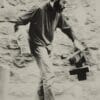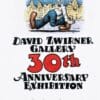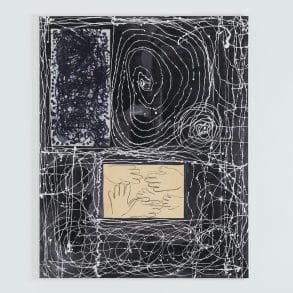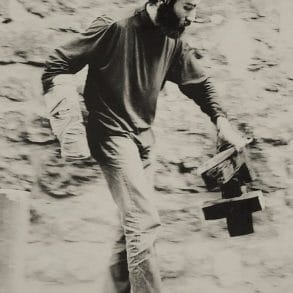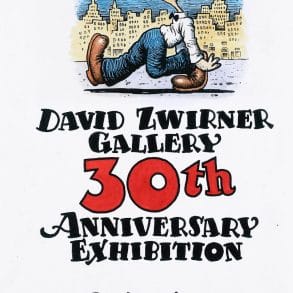Washington, D.C. – Morton Fine Art is pleased to present an exhibition of ink on paper drawings from an ongoing eco-queer focused series by Johannesburg, South Africa-based transdisciplinary visual artist Hannelie Coetzee. Bringing together recent drawings—a medium Coetzee has freshly pursued since the pandemic—In mid-loping gait focuses on the artist’s fluid embrace and trenchant application of drawing. Wedding her engaged, direct observation of wildlife with deep research into zoomorphism and queer ecology, the exhibition rethinks ways of being (human) through actual ways of (animals) living, viewing animal life as another nation on par with human life. Coetzee’s first solo exhibition with the gallery, In mid-loping gait will be on view from November 11 to December 19, 2023, at Morton Fine Art’s Washington, D.C. location (52 O St NW #302).
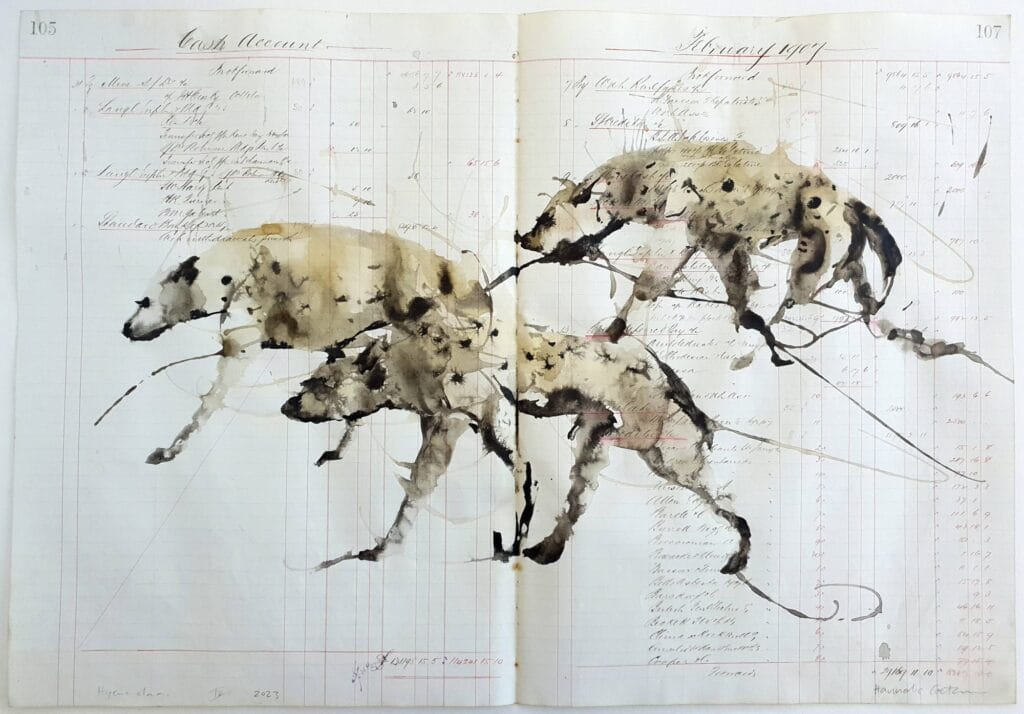
Hyena clan lV, 2023
Ink and rooibos tea on acid free paper
470mm x 680mm
Courtesy the artist and Morton Fine Art
Returning to drawing for the first time since childhood, Coetzee’s ink on paper works are propulsive, almost electric renderings of queer behavior in a suite of animals: hyenas, wildebeests, zebras, warthogs and giraffes. Informed by a foundational reading of eco-queer theory and art1, Coetzee’s first steps were very much to become knowledgeable and sensitive to other ways of being—to being otherwise—as demonstrated and embodied by animals. Coetzee shares glimpses of giraffes necking and warthogs bounding about, intently observing them in their own social worlds. Long engaged in an environmentally-focused, research-based and site-specific practice, Coetzee’s work in drawing finds the artist in a free and improvisational, albeit still decidedly rigorous mode. Freezing glimpses of queer intimacy in animal life, the drawings on view wordlessly express one of queer ecology’s main tenets, demonstrating an often contested matter with just a few stained pools and lashes of whipping ink lines: that the purported “unnaturalness” of human queerness is rebutted by common, everyday queer behavior in the natural world.
Restricted during the pandemic, like so many others, Coetzee began to prioritize trips to view wildlife first hand, drawing wildebeests, baboons and hyena out the window of her car in Kruger National Park. Trips to the Bushveld followed and allowed more en-plein-air opportunities. Deeply “participating” with the natural world, Coetzee recognizes the qualities of a dance in these works, particularly in respect to the animals’ movements. Recording a range of glances, positions, postures and gestures, the drawings in In mid-loping gait emerge through empathy and economy. With each and every drawing and subsequent redrawing in the studio, Coetzee distilled down her labor and her subject’s actions into a few strokes. Moreover, Coetzee occasionally let the wet ink run in the wind and be propelled by her own paper motions in concert with the animal scene before her, such that the end result looks like the animals are shaking their head or body or caught mid-act—drawing a paired relationship between both their actions.
Variously stained and streaked, Coetzee’s quietly liberated menagerie exerts a certain hold on the paper. The hyena holds a particular place of interest for Coetzee. Misunderstood, marginalized underdogs, Coetzee captures them in assured and composed collectives.
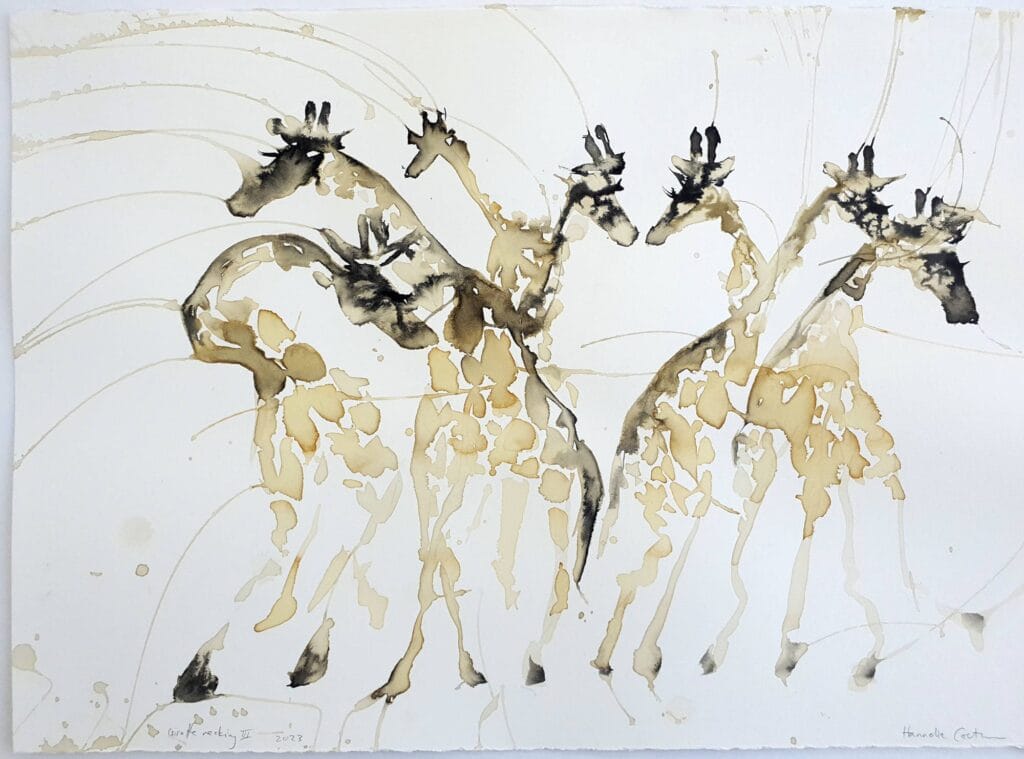
Giraffe necking lll, 2023
Ink and rooibos tea on acid free paper
355mm X 500mm
Courtesy the artist and Morton Fine Art
Choices of material, location, collaboration have long been fundamental considerations for Coetzee and her process, her practice deeply probing questions and dimensions of materiality. At least five different types of paper stock are used among the works in the exhibition. Coetzee explored the papers’ texture, surface appearance and permeability. Many of the papers are sustainably sourced or from found and salvaged industrial documents, including pages from mining ledger books. Placed in these industrial settings, Coetzee’s animal portraits take on
socio-political dimensions, raising questions of “naturalness/unnaturalness” while alluding to concerns of climate change, loss of habitat, freedom. In mid-loping gait wields queer eco-art as a transgressive tool to bring about a more diverse climate culture for the future.

Wildebeest l, 2023
Ink on acid free paper
351mm X 500mm
Courtesy the artist and Morton Fine Art
Working in a relational manner, Coetzee has used skeletons and sculptural works as “models” for drawings and now drawings as “blueprints” for sculpture works. Use of discarded, repurposed materials is a mainstay of many of her public projects. Leaving a light footprint while leaving a substantive mark, Coetzee’s practice is informed by place, material, research as well as her background in photography and the sciences, having completed a transdisciplinary Master of Science Degree (MSc) in Global Environmental Change in eco-cultural environmental sustainability at the Wits Animal, Plants and Environmental Science School (2022). Stepped in both these worlds, Coetzee is doubly sensitive to their limits and potential. Thus, while feeling deeply “welcomed” in the natural world by actual eco-queer creatures, Coetzee thoroughly understands the fragile foundation upon which life lives on Earth.2 She also recognizes the privileges of her positions and the various manner in which knowledge is created and shared.
Favoring grassroots knowledge, Coetzee seeks knowledge that builds upwards.
An anti-zoo of liberated animals, In mid-loping gait signals how nature has always been visibly, if ‘silently’ queer.
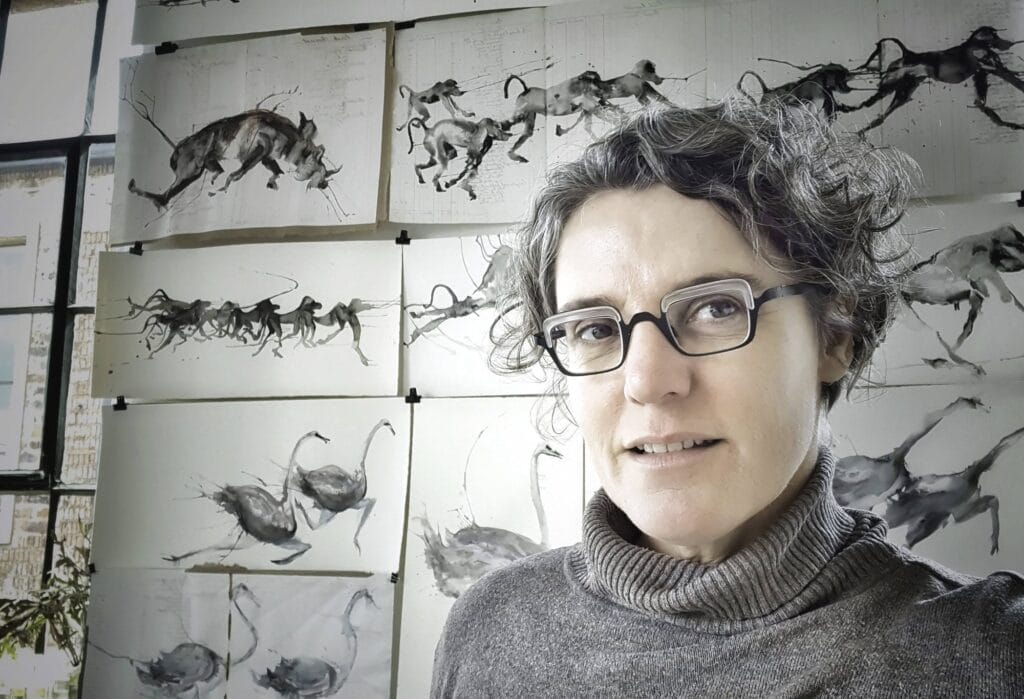
Hannelie Coetzee in studio, 2023 with eco-queer drawings
Photo credit: Hannelie Coetzee
Hannelie Coetzee (b. 1971, South Africa) is a visual artist based in Johannesburg. Her relational practice regularly centers on public spaces, where she produces artwork that ranges from ephemeral to permanent. Originating out of her respect and concern for the environment, Coetzee employs found materials, most often reclaimed industrial waste, to form unlikely partnerships with the surrounding land. Research into these materials and the context of their deployment on-site remains a fundamental component of Coetzee’s process, allowing her to orient her work around its immediate community and locate meaning inherent to the materials used. Across disciplines, Coetzee’s practice seeks to marry environmental science and social action to better encourage empathy for and engagement with nature.
Coetzee received a BTech degree in social documentary photography from the Vaal University for Technology in 1994, followed by an Advanced Diploma in Fine Arts at the University of the Witwatersrand (1997, Wits). She worked internationally as a photo essayist for two decades documenting stories of change, principally for corporate sustainability reports. Having studied Social Entrepreneurship at the Gordon Institute for Business Science (GIBS) on a Rand Merchant Bank Grant in 2013, she subsequently began incorporating an eco-cultural approach to her relational aesthetic interventions. In 2022, Coetzee was invited to and completed a transdisciplinary Master of Science Degree (MSc) in Global Environmental Change (GEC) in
eco-cultural environmental sustainability at the Wits Animal, Plants and Environmental Science School. Recently, she has written about the role of helping society adapt to a warmer world in MIT’s Leonardo Journal.
She has been represented by Morton Fine Art since 2023.

Artwork for Hermanus Sculpture on the Cliffs, 2023
Title: Penguins Bowing, 2023
Series: Queer inquiries in non-humans
Medium: Found metal and stone
Size: 1m high X 2m wide X 0.5m deep
Photo by Jaco Sieberhagen

